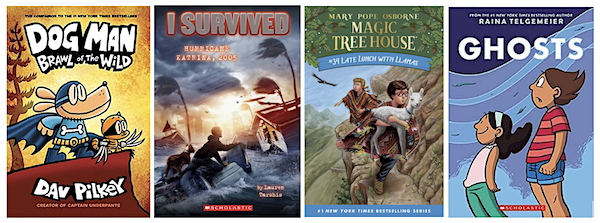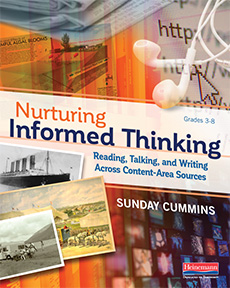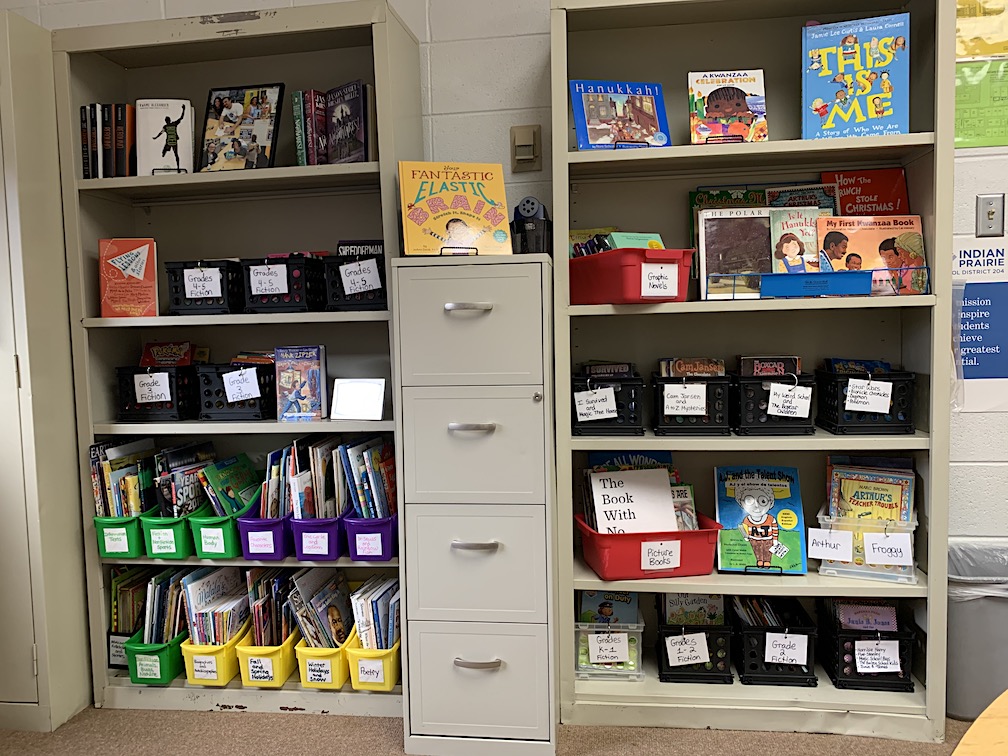Helping Kids Travel the Bridge to Joyful Reading
By Meghan Duermit and Sunday Cummins

Meghan
Reading teachers work hard to meet the needs of individual students in small group settings. And yet, many students continue to struggle while reading self-selected books.
This struggle works against their sense of agency and identity as readers. What can we do to build stronger bridges from guided reading with specialists to independent reading?

Sunday
Here’s an idea. Host experiences that nurture successful transfer. Meghan has been exploring what this might look like for the students in the intermediate grades she works with as a reading interventionist.
She’s found that providing access to high-interest books, coaching students in choosing “just right” books, and conferring with students as they read these books are important scaffolds we can easily provide our students.
Provide high-interest books in a smaller setting.
In her specialist office space, Meghan has a library of high-interest books. She encourages her students to read these books for pleasure and doesn’t limit them to particular “levels” of books (Walski, 2020). The books are categorized not by level, but by topics like sports and the human body and also by series (e.g., I Survived series by Lauren Tarshis and Magic Tree House series by Mary Pope Osborne).

The books are organized into bins so students can easily flip through them and also in a rotating display based on particular themes like holidays and seasons. This can pay off for your students. As one student told Meghan, “It is not as overwhelming to choose a book [in your office]!”
If you are a reading specialist and do not have access to a smaller library, consider taking students to the school library and showing them where titles they might think are intriguing reside. This could be just enough support (Miller & Moss, 2013) for students to find and continue finding books they want to read.
Coach students on “just right” book choices.
We know that in order for students to grow as readers, they need plenty of time beyond instruction to read books successfully (Allington, 2014). Part of this success depends on the student choosing “just right” books for independent reading.
This means they need to find books they want to read as well as books they can read – usually with 98-100% accuracy and adequate comprehension (Almasi & Fullerton, 2012; Springer, Dole & Hacker, 2017). While Meghan’s library is not “leveled,” she does still support students in choosing books they can enjoy and feel successful at reading.
Three suggestions for what this might look like include:
✻ Recommending titles based on the student’s interest, pulling from your smaller library for students to check out. If you don’t have a library, make some of these titles available (e.g., first book in a series like Dog Man) so students know what to look for in the school library.
✻ Explicitly teaching students how to use the “5 Finger Rule” to find a “just right” book. Model for students how to skim a page in a book for the number of words they cannot read as a way to determine if there are too many (more than five on a page) for them to be able to read the book with some ease and pleasure.
✻ Conferring with students as they start reading self-selected books to check for adequate comprehension.
Confer with students on the bridge.
Meghan’s district has adopted a program for reading intervention that she implements five days a week with several small groups of students. Two to three days a week, though, she sets aside 10 to 15 minutes for students to read books they’ve self-selected.
When she leans in to confer with individuals, she starts by asking them to share a little bit about what is happening in the book and why they like the book. Then she asks them to read a bit to her. Her purpose in doing this is two-fold.
✻ Meghan can assess whether the book is a good fit for that student.
✻ She can also coach for transfer of the skills students have learned during the program’s lessons, helping them travel the bridge.
Even During the Pandemic
A pandemic doesn’t change our purpose or goal as educators, right? Our students still need to be supported as they cross that bridge from instruction to joyful independent reading. Meghan and her colleagues are encouraging students to access books online via the school’s subscription to Tumblebooks, a database of children’s ebooks.
They have also alerted families to free online trials at sites like Scholastic and Reading A to Z. Many public libraries also have collections of ebooks (and have started granting library cards virtually). While these are not hard copies of books, they are still viable reading experiences for many families.
The trick is to stay in touch with students as they make these virtual book choices. As we face the possibility of more distance learning this fall, we are asking ourselves questions for further inquiry. Questions like: What are the possibilities? A reading conference via Zoom about a book a student is reading? Corresponding with students about their reading via Google Classroom or SeeSaw?
We will have lots to explore professionally this fall. Regardless, the onus is on us, as reading teachers, to help our striving readers cross the bridge from instruction to joyful reading. We can do this by partnering with students as they choose and read books for pleasure.
References
Allington, R. L. (2014). How reading volume affects both reading fluency and reading achievement. International Electronic Journal of Elementary Education, 7(1), 13-26.
Almasi, J. F., & Fullerton, Susan King. (2012). Teaching Strategic Processes in Reading. New York, Guilford Press.
Miller, D. & Moss, B. (2013). No more independent reading without support. Portsmouth, NH: Heinemann.
Springer, S. E., Dole, J. A., & Hacker, D. J. (2017). The role of interest in reading comprehension. In S. E. Israel & G. G. Duffy (Eds.), Handbook of research on reading comprehension (pp. 519-542). New York: The Guilford Press.
Walski, M.M. (2020). Leveled Texts: How and When Teachers Should Use Them. Illinois Reading Council Journal, 48(2), 41-46.
Meghan Duermit is a Reading Specialist in Indian Prairie School District #204 in Aurora, Illinois. She has been a Reading Specialist in the district for many years and has worked with struggling readers in Kindergarten through Grade 6. She teaches interventions to strengthen student’s reading skills and also provides professional development at the school and district level and at state conferences. Over 22 years, she has been a classroom teacher, literacy coach, and reading specialist and loves to share her joy of reading with her students.

Sunday is a graduate of Teachers College, Columbia University, and has a doctorate in Curriculum and Instruction from the University of Illinois, Champaign Urbana. Visit her website and read her regular blog posts on teaching information literacy. Follow her on Twitter @SundayCummins.



































